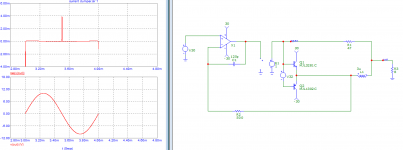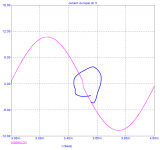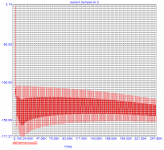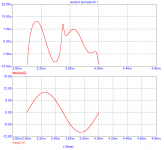I think the Benchmark AHB2 power amp is a kind of current dumper crossed with Class H variable rails but I wouldn't bet my life on it, just remember reading it somewhere.
IIRC not full off output stage, makes a big difference. In any case the Quad amp and the ABHB2 have what amount to lots of error correction and feedback and I can not believe would show anything like 100X distortion anywhere in this test.
I read in an article about mixing that higher frequencies tend to be perceived as elevated, I would expect bird song also to seem higher since that's what we would expect to hear. As I mentioned earlier we are subconsciously trying to make sense of what the speakers are presenting us with, the illusion, for most of us, is easily created.
How do you describe Qsound as in Roger Waters' Amused to Death, or better yet the characteristics of some of the Decca London carts from the 60's-70's? Same effect but the Decca does it on all records. Amazing. Must have to do with phase manipulation. The Bedini B.A.S.E. processor puts you "inside" the sound stage.We can easily measure the signal
-Chris
Haha ye I will avoid the designs with "150 X7R in the signal path" in the future
https://www.edn.com/signal-distortion-from-high-k-ceramic-capacitors/
It is quite spectacular. But I see white ceramic caps on the board also, so they probably used C0G for the bass boost filter... probably... hopefully... maybe?
This is not the QUAD current dumping stage. It misses the balanced bridge feedback which was the whole point and makes all the difference!
How can a bridge be balanced when one of its impedances is in series with the highly variable and non linear output impedance of an unbiased class B output stage? OK, I added the bridge, with a 0 distortion NE5532 model, an ideal driving stage, and the bridge components from the article.
I don't like the look of this distortion residual, it is... spikey.

Messing with the bridge increases the crossover spike, so it does work. But the output signal of the opamp has to slew a lot when the transistors are off, so...

"smooth harmonics rolloff"

- "all the harmonics are below 100dB!"
- "yeah but there's a gorillion of them!"
The irony is, that with a bit of bias on the transistors (50mA), then the balanced bridge really works. First, because the opamp doesn't get a kick in the slew rate at each crossover, and second because the output impedance of the power stage varies less, so the bridge stays more balanced. The residual is tiny. They had an idea that would work really well with a bit of bias, and they used no bias at all.

So, thank you for recommending that, I had disregarded it because of the predictably bad results with a class-B output stage, so I had not thought about using it with a class-AB output stage...
Hi,
Why the devil would I even attempt to describe specifics of things I have not yet measured? I already said I won't entertain the thought of specific examples as they would be a massive waste of my time. Not unless you want to foot the bill for the lab time and setup.
Try and be reasonable and look at things that are of value. If you want to trot out specifics that you haven't even measured, you are wasting your time as well as everyone else's.
Why the devil would I even attempt to describe specifics of things I have not yet measured? I already said I won't entertain the thought of specific examples as they would be a massive waste of my time. Not unless you want to foot the bill for the lab time and setup.
Try and be reasonable and look at things that are of value. If you want to trot out specifics that you haven't even measured, you are wasting your time as well as everyone else's.
Perhaps we still are in the twilight zone about the interpretation of the signal wrt spatial cues, which obviously is within our ability to hear. Hopefully I could still witness us gaining clearer understanding on the matter before my time is up.Most folks don't know how to interpret what the readings are, and I am getting better at it every day. But, I am measuring things well below your ability to hear it.
Now you call me a liar? I get that illusion nonetheless, whether it was a true location or not is irrelevant. I want to know what it is in the signal that brings about that illusion for so many of us, including myself.I'm hearing for years BS about stereo systems allowing instrument 3D spatial location, which is a physical impossibility.
I do not mean measure where they are supposed to be, simply determine if a particular recording has depth/height or not. I have repeatedly read "If somebody can hear it then it is measurable". Then my understanding is that we still do not understand a lot of what is measurable.Everything, all the instruments in different places, is mixed up together in the recording, there's no way to separate them afterwards so you can't measure where they are supposed to be.
Last edited:
Yes, everything is an enthusiastic interest only, until you start retailing or producing & selling something, then it becomes a profession - unless they're doing it on the side, or have an underling / manager, although then it's still a side-profession or they are lazily dictating to their underling what kind of results they are looking for.
Agree - and it is called *business* even if it doesn't make a profit or even loses money. Its still a business.
Once you take money for something it better be worth the sum to the buyer or it is a scam. Profit or loss to the business doesn't matter - a scam it still is.
In a good deal - both sides are winners
//
As the saying goes, business is business.I don't know about that noise clock story. But I have observed that people that came here for a "mission" will be so emotional when someone gets in the way.
That's your problem, right?You sure about that ? The ability to agree to disagree is sometimes in short supply around here.
That would mean the lab equipment has a mind to begin with. Such news would have been all over the world.Lab equipment changes it mind when it starts measuring a new parameter. Or the human adjusts something.

Now you call me a liar? I get that illusion nonetheless, whether it was a true location or not is irrelevant. I want to know what it is in the signal that brings about that illusion for so many of us, including myself.
I do not mean measure where they are supposed to be, simply determine if a particular recording has depth/height or not. I have repeatedly read "If somebody can hear it then it is measurable". Then my understanding is that we still do not understand a lot of what is measurable.
Hi, the illusion of 3d in reproduction is usually a mixture of different factors including acoustic.
Syn08 is mostly true: there is no way to 3d with stereo ( at mixing stage or reproduction) BUT you can give the feeling using phase manipulation for example ( Boss/Roland RSS) or a mix using freq/phase/delay in motion ( some synthesizer filters can give you this feeling of 'elevation' too, some treatment using doppler effect was convincing for front/back moves and 'circle' motions in Emu E-series samplers).
About acoustic recording and 3d when experienced in reproduction i would say it is an acoustic illusion between room, loudspeakers and your brain.
The difference between 'flat' and with 'depth' recording comes from the production techniques used at recording/mixing. As ScottJoplin stated there is no mysteries about this in pro field. It is a matter of locating microphone(s) where it (they) should be located to induce depth ( in a real reverberant space) or not ( multi miced source in dry/dead acoustic then post processed), and play with the limitations to make them disappear/hide them.
The technician who located the mic to record the birds didn't know about how you would ear them in your neighbour tree but it is a nice coincidence it sound the same to you. It is your brain which tricks you as it sound 'alike' a reference you have. The rest of the illusion is self processed in your brain whith your own set of references it triggers along...
Last edited:
Insults like the following examples?you get immediately personal attack and insults.
Because you don't post, you copy and paste.
Of course, I cannot share the oscillator you have published since it was very poor.
Just to recall, the poor oscillator compared to a state of the art oscillator (6.144 MHz).
- Status
- Not open for further replies.
- Home
- Member Areas
- The Lounge
- Sound Quality Vs. Measurements